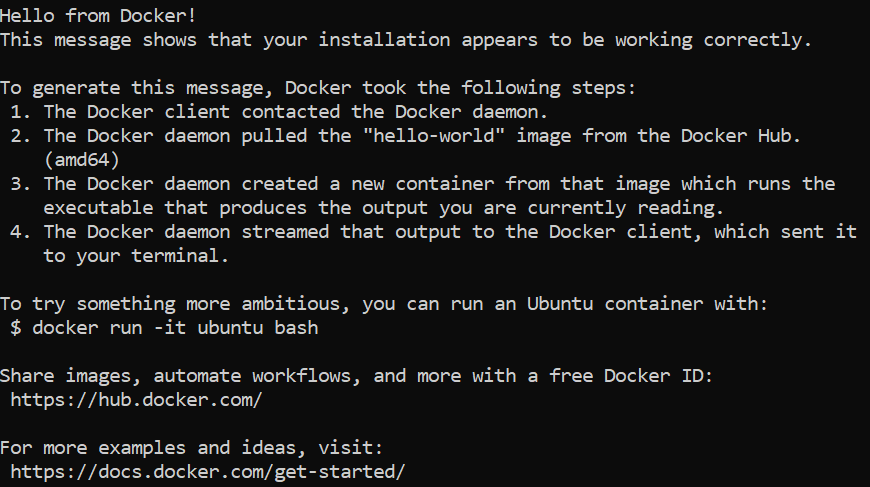
- #UBUNTU INSTALL DOCKER DESKTOP HOW TO#
- #UBUNTU INSTALL DOCKER DESKTOP INSTALL#
- #UBUNTU INSTALL DOCKER DESKTOP DRIVER#
- #UBUNTU INSTALL DOCKER DESKTOP UPGRADE#
- #UBUNTU INSTALL DOCKER DESKTOP PORTABLE#
For example, if you are using Linux Mint Tessa, you could use bionic. Sometimes, in a distributionlike Linux Mint, you might need to change $(lsb_release -cs)to your parent Ubuntu distribution. Note: The lsb_release -cs sub-command below returns the name of yourUbuntu distribution, such as xenial. To add the nightly or test repository, add the word nightly or test (or both)after the word stable in the commands below. Use the following command to set up the stable repository.
#UBUNTU INSTALL DOCKER DESKTOP INSTALL#
Update the apt package index and install packages to allow apt to use arepository over HTTPS: Afterward, you can install and update Dockerfrom the repository. In testing and development environments, some users choose to use automatedconvenience scripts to install Docker.īefore you install Docker Engine for the first time on a new host machine, you needto set up the Docker repository. This is useful in situations such as installingDocker on air-gapped systems with no access to the internet.

Some users download the DEB package andinstall it manually and manageupgrades completely manually.
#UBUNTU INSTALL DOCKER DESKTOP UPGRADE#
Most usersset up Docker’s repositories and installfrom them, for ease of installation and upgrade tasks. You can install Docker Engine in different ways, depending on your needs:
#UBUNTU INSTALL DOCKER DESKTOP DRIVER#
If you need to use aufs instead, you need to configure it manually.See use the AUFS storage driver Installation methods Docker Ubuntu Setup Proxy Supported storage driversĭocker Engine on Ubuntu supports overlay2, aufs and btrfs storage drivers.ĭocker Engine uses the overlay2 storage driver by default. If you do not need to save your existing data, and want tostart with a clean installation, refer to the uninstall Docker Enginesection at the bottom of this page. The contents of /var/lib/docker/, including images, containers, volumes, andnetworks, are preserved. It’s OK if apt-get reports that none of these packages are installed. Older versions of Docker were called docker, docker.io, or docker-engine.If these are installed, uninstall them: Users runningDocker on Ubuntu 16.04 are recommended to update their system to a currentlysupported LTS version of Ubuntu.

Docker no longer releases packages forthis distribution (including patch- and security releases). Ubuntu Linux 16.04 LTS reached the end of its five-year LTS window on April30th 2021 and is no longer supported. Ubuntu 16.04 LTS “Xenial Xerus” end-of-life To install Docker Engine, you need the 64-bit version of one of these Ubuntuversions:ĭocker Engine is supported on x86_64 (or amd64), armhf, arm64, and s390x architectures. To get started with Docker Engine on Ubuntu, make sure youmeet the prerequisites, theninstall Docker. See Hub Vulnerability Scanning for more information. If you have a Docker Pro, Team, or a Business subscription, you can automatically scan images when you push an image to Docker Hub. Run docker scan to start securing your images using Snyk. Using open source components in your container images can introduce vulnerabilities. To do so, type in each command followed by enter: sudo systemctl. The Docker service needs to be setup to run at startup. To install Docker on Ubuntu, in the terminal window enter the command: sudo apt install docker.io Step 4: Start and Automate Docker. Sudo apt-get remove docker docker-engine docker.io Step 3: Install Docker on Ubuntu 18.04.


Portainer CE is a free and open-source tool that manage.
#UBUNTU INSTALL DOCKER DESKTOP HOW TO#
#UBUNTU INSTALL DOCKER DESKTOP PORTABLE#
Docker is an open-source containerization platform that allows you to quickly build, test, and deploy applications as portable containers that can run virtually anywhere.


 0 kommentar(er)
0 kommentar(er)
